This is a followup to my first post where I talked about the wonderful world of tools and art toys that exists outside the mainstream.
Some months ago I asked if there was interest in another one of these, and yes. There was interest!
The level of interest that exists for freeware and shareware tools (in general, tools made by small creators) is really exciting to me.
We see genuine enthusiasm for quirky artistic tools… things that you could basically call a creative “toy”.
These things are like a breath of fresh air. To me, they remind me why it’s fun to make stuff on a computer.
Small tools by small devs, made to serve a specific creative niche, bring me back to my earliest memories of creating stuff on a computer with these silly edutainment programs, or things like Mario Paint (which I regularly gush over in my posts).
It says a lot that things like Kid Pix are still talked about. That people still seek out these old programs. That there’s a craving for that interaction you get when creating with weirder software. It’s like these memories we hold onto about games (basically nostalgia), translates to art tools too. They are a flavor that we crave and miss.
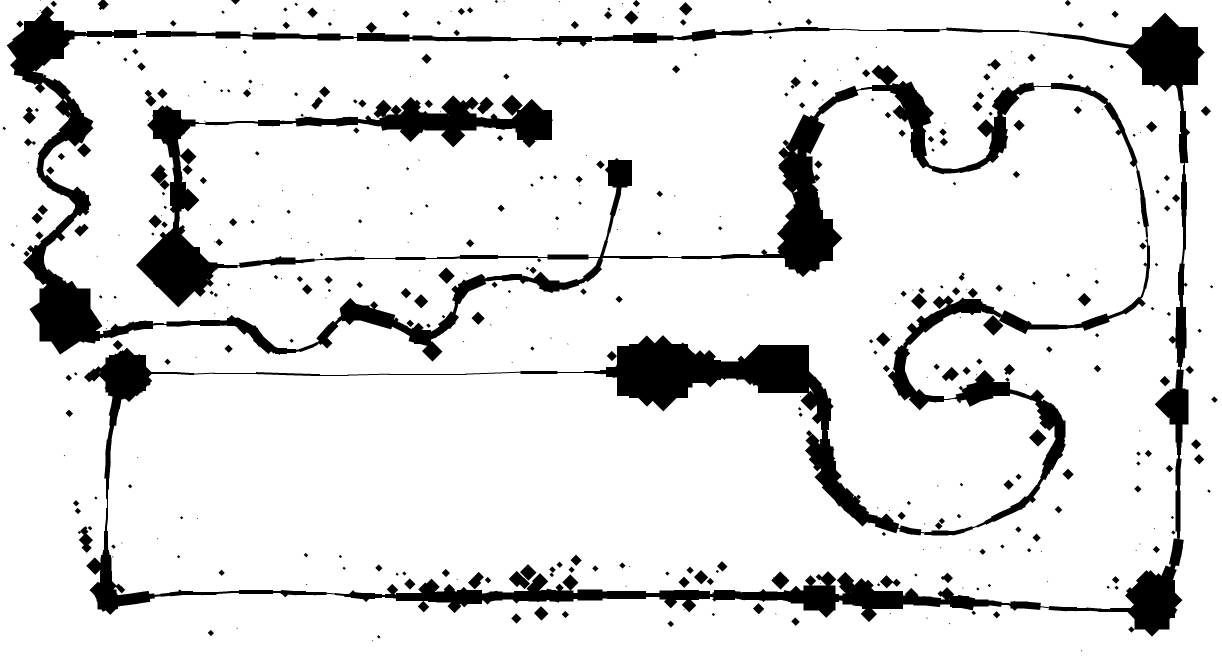
When I started working on the Electric Zine Maker I fell heavily into exploring all the stuff that was out there. It surprised me that there was so much.
The thing that I find the most valuable about these experimental and often silly tools is how they fill a creative niche.
I participated in a few prerelease things for mainstream and corporate software… it’s really interesting how the larger and more popular a tool gets the more it fixates on the popular use cases.
Artistic approaches in mainstream tools are heavily centered around market demand. So whatever trend, aesthetic, industry need, is most popular is what gets built.
When you contrast that against these smaller tools, you see how valuable they become. These smaller things that are free from the grind of industry demand or standard, that focus on more obscure visual styles, tones, needs… They open up creative doors specifically because of how niche they are. They make unusual things accessible to us.
Even while building the Electric Zine Maker I start to see certain aesthetics become more accessible to me that I know would take a lot more effort to pull off in a professional tool, because that professional tool is really meant for different purposes.
These small things help us discover our creative voice. That’s why they are valuable!
There’s this adorable animation software I found on itch. It’s called Clipnote Studio:
https://calcium-chan.itch.io/clipnote
This is just incredibly adorable! Everything about it, especially the tiny window size, the restriction, the very specific tool-set, the very compact UI… is brilliant.
This is one to observe for how I don’t think it would be as like-able, or even fun, if it were bigger with a larger feature set. Its “unprofessionalism” (for a lack of a better term, but in this context that’s a very good thing) is why you get so engrossed. It’s a silly little thing. It does not judge me for just wanting to scribble. It makes cute sounds when I draw. Just the interaction is fun.
Tools like Clipnote Studio are more like a toy. Creating in them is as engaging as playing a game. The exchange you have between software and yourself is fun. It’s almost like getting engrossed in your Legos, or how you lost track of time while squishing Play-Doh.
The simplicity, the focus it has on that very limited set of features, is a benefit. For any toy-tool like this the limitation is what makes it loveable.
I don’t get overwhelmed trying to learn it or have to deal with the feeling that “I’m not good enough for this!” I’m not afraid of it.
I highly recommend checking it out. It will make you feel like a kid again.
There’s also another tool made for Clipnote Studio called Paperclip which lets you convert and export animations made with Clipnote. Get it here: https://meatsphere.itch.io/paperclip
I think it’s so cool to see these little things growing around something indie. Like a person makes this tool, and other people make tinyer tools for that tiny tool. It’s sweet. It’s why it’s great that freeware still exists.
I think it’s why computers are still interesting. Devs give us access to niche ideas and we can explore these strange, new, unusual creative concepts together.
There’s a treasure trove of tools out there. There are so many, you basically can’t keep track. I try with my Cool Tools collection here: https://itch.io/c/235488/cool-tools
Small things that you could basically dismiss as hobbyist are actually a vital part of the tech ecosystem. The freedom to create software, at this small scale, and distribute that software outside of controlled marketplaces is so important. It’s a fundamental right imo, because without it… I don’t know. Computers would just basically be what mobile phones have become. Outlets for you to consume content made by larger companies that can afford being on a device.
It’s kind of an ecosystem that’s always going to be at risk. We see how Epic and Apple are fighting right now. I don’t care to get too much into it because criticizing these monopolies, and their marketplaces, is something I’ve done a lot (Read my post about Apple’s Catalina notarization issue).
I think an interesting observation to add is, I remember that Adobe had a fight with Apple to open up the AppStore to non-apple development software like AIR and PhoneGap. There was a legal thing? That was before the “Thoughts on Flash” article. It’s a vague memory, a long time ago, and I paraphrase heavily… (EDIT: this is what I’m talking about. You can still find a history of it online) but these things keep happening… Either way, small devs that make these small tools or indie games are the ones that suffer first. They’re the canary in the goldmine when it comes to our freedom to make and share stuff on machines.
The slow deteriorating loss of our spaces, and outlets, worries me. In the Flash days there was so much access to cool stuff in the browser. Animation tools made in Flash that you could visit in a website, and output cute animations that you shared. Websites that let you make games in them, all comparable to desktop apps… They were a dime in a dozen. The web was THE accessible platform for everyone. It’s in a website, it’s easy to share! Flash made that much more accessible than things have become today.
The bar for making web stuff has risen much higher since the web got “cleaned up”. Creative stuff like that is harder to pull off, consistently, between browsers, while honoring the growing restrictions that browsers place on what a website is. I see this same thing happening to the desktop too.
I think it’s a hard shift to justify if you consider that the conversation changed from Casual Games in the browser being an actual “big industry”, to people now saying that “the browser is not meant for games”.
Where would we be if we didn’t have software one-offs? Silly experimentation that lets you explore just that one concept, just that one niche?
When I find stuff like vdcrpt (“video corrupt”) it kind of reminds me of the software version of memes. Like these one-off, very novel, quirky things that are a response to a certain aesthetic.
vdcrpt (“video corrupt”) is a program that corrupts videos. You get those broken glitch effects. Is it weird that I actually find this useful? Glitch has become such a popular aesthetic. It’s wonderful to have a tool that specializes in breaking video.
I have a copy of Glitchy3bitDither saved to my desktop, and hold onto it for dear life. It’s this amazing little javascript thing that you can run your image through, and it offers a number of popular image glitching and compression effects. I’ve had it for years. I’ve tried to re-create my own version of that, but somehow this is just the best for me. It does it just right. It’s become a really important tool, even tho it’s so incredibly niche.
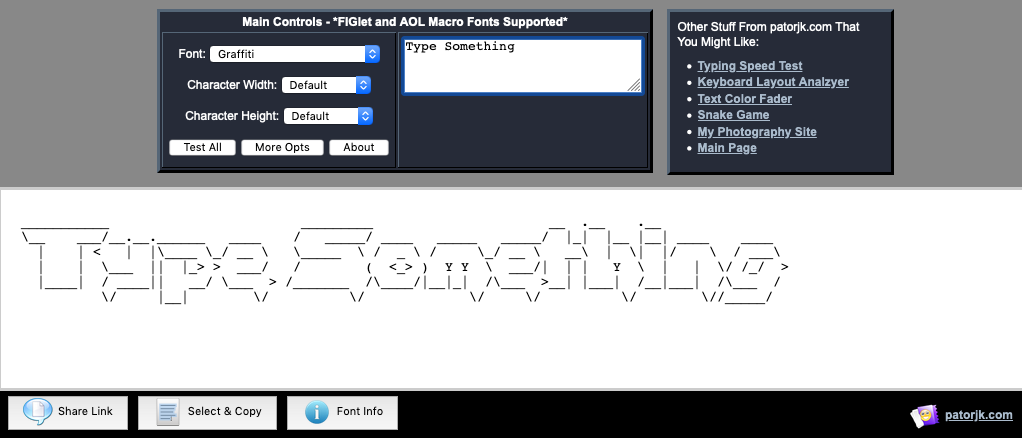
These things tend to become invaluable to you, in very personal secret ways. I use this text to ASCII art converter ALL the time: http://patorjk.com/software/taag/#p=display&f=Graffiti&t=Type%20Something%20
Or silly generators like http://animalswithinanimals.com/generator/generator.html and then there’s this adorable toy for just having fun with text: https://yellowafterlife.itch.io/13443r80x
You don’t know how much you need them until you start finding use for them.
Art software made by corporate entities always has you agree to an EULA before using it… Tools like this have none of that, and I feel like it’s an important thing to keep contributing. Things like freeware, or models of “buy me a beer if you like this!” have always existed in the software space. They need to keep existing to keep tech democratic. Tech can’t only exist to serve the needs of monopolies.
These tools, all that work from small devs and the resulting creative freedom, should not be taken for granted.
What a computer is, and our freedom to build and distribute whatever we like is something that I wish we would protect more. Even the definition of what a desktop is and what we allow to run on it, should be in the hands of “the people” not the monopolies that own the space.
I really wish the discussion would shift. It’s popular to just keel over and agree that getting rid of any number of digital freedom we have is “for security” when Orwellian policies, or getting rid of our digital freedom altogether, are hardly the way to approach security. I think, if anything, losing Flash and how easily we swallowed that Flash-is-bad-hate-Flash-meme taught us that. Was it really progress to destroy such a immeasurable chunk of internet and game history without alternatives to properly access it? Is it really progress when we lose so much? Are websites really faster now that banner adds are in HTML5? Security issues transferred to javascript… It’s not “open standards” when Google is still the driving force dictating what standard goes or stays. Plugins where never the issue. Freeware is not a threat. Our monopolies are. I will die on this hill.
Seems like a good day to announce that I received a Hellman Fellows award to develop an Open Source Afro Hair Library, an antiracist database for high quality 3D models of Black hair.
Read about my research and the necessity of this project here: https://t.co/mmcV39CN8U
— a.m. darke (@prettydarke) June 19, 2020
“Across digital media, accurate and diverse depictions of Black hairstyles and textures are generally confined to NBA sports video games, but even that representation is only of Black male players. Outside of these basketball video games, Black people, regardless of gender, are often portrayed in ways that are derogatory, inaccurate, stereotypical, demeaning, and otherwise harmful–if they are depicted at all.”
So I couldn't find any natural hair brushes for black hair textures that I liked, so I made my own and they came out really pretty!
You can get them here: https://t.co/xQlLqq6Kx2
or join my brush club to get all my brushes for just £9 for a limited time: https://t.co/hZGj1jcilO pic.twitter.com/x2WN4IVpkY— ????????? (@SimkrayINK) August 13, 2020
“So I couldn’t find any natural hair brushes for black hair textures that I liked, so I made my own and they came out really pretty!”
What all these creative assets, tools, add-ons, and toys, enable us to do is be empowered to make better art. There’s an awareness for what you are doing that comes with each of these. These things are a huge public service.
Pixel art is another beautiful example. It’s popular, but it’s actually really hard to get quality solutions working in mainstream tools. I’m aware of how to pull that off in Photoshop, but at the same time sometimes it’s harder than it should be.
So you have these tiny things like Pixelator (which converts images into pixel art sprites), or Pixatool (which lets you do that with video too and is a lot more elaborate), Paint of Persia (which is this incredibly useful rotoscoping pixel-art tool that lets you draw on top of things), and finally Pixel FX Designer (which lets you design amazing particle effects as pixelart)… It’s interesting how super specific each of these are, and how they all go about trying to solve that one similar problem.
Even as you use each of these tools, the type of work you make in it (the visual style) will vary. Devs often make tools for building their own games. Sharing these hyper specific things is kind of like contributing to a larger creative narrative.
I mean, when you look at it in context of how much amazing stuff is out there, it really sucks when we place so much emphasis on just that one monopolized tool set. We NEED the alternatives, and our platforms need to keep allowing things made by hobbyists. Without it, creating on computers would just be a grind best left to professionals.
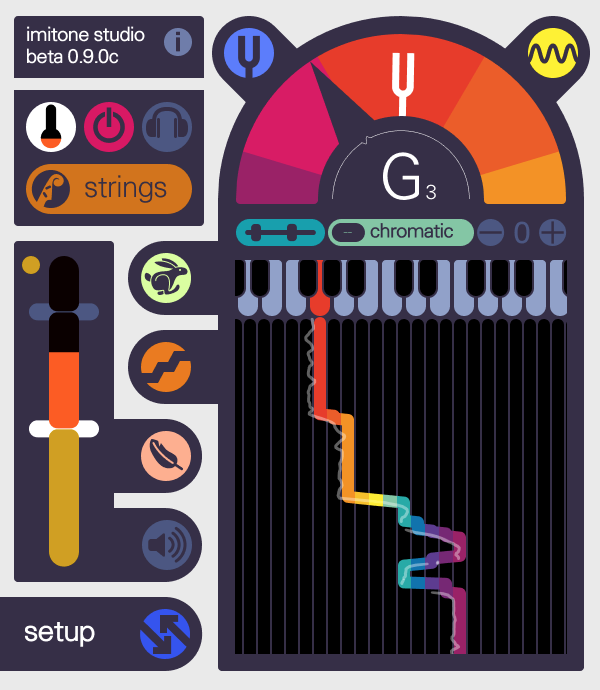
So ok. This is getting long and I should probably wrap up, but I’ll end with some recommendations for music too!
…This way you have your animation and art programs, then you can follow that up with music. Maybe go make a cute music video using all these quirky little things!
One music program… toy?? that REALLY deserves a big mention is Imitone.
Imitone lets you play music with your voice. This is actually huge imo because I have no music background and struggle a lot when I have to compose something that isn’t ambience or drums. This solves that problem for people that don’t know how to write music. It translates that to MIDI, which you can use in other software.
ASIDE from that very specific and helpful public service, it’s also a fun toy. The UI is adorable. It looks inviting. It literally looks like a digital instrument. It gets really engrossing… like you get into it and lose all track of time.
I highly recommend trying it. Even if music is not your thing, just the UI work is worth looking at.
Which I guess gets me into the wonderful world of procedural music generation!
Because sometimes you don’t know what you’re doing, but it’s OK, there are lots of tools out there to help you make something cool… that gives the impression that you know what you’re doing because you just made something very cool. :)
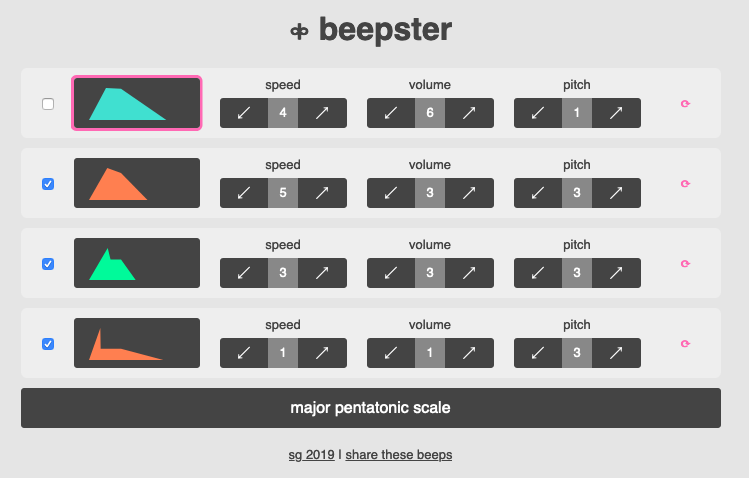
Beepster https://zenzoa.itch.io/beepster
Beepster is amazing. This is super simple. It requires no knowledge of anything really. There’s a bunch of buttons you press to increase or decrease values. You press them, it keeps generating a tune. When you’re done you can share the bleeps with your friends. It’s therapeutic to play with, but also useful because you can record what you do and just use that.
These are my favorite beeps.
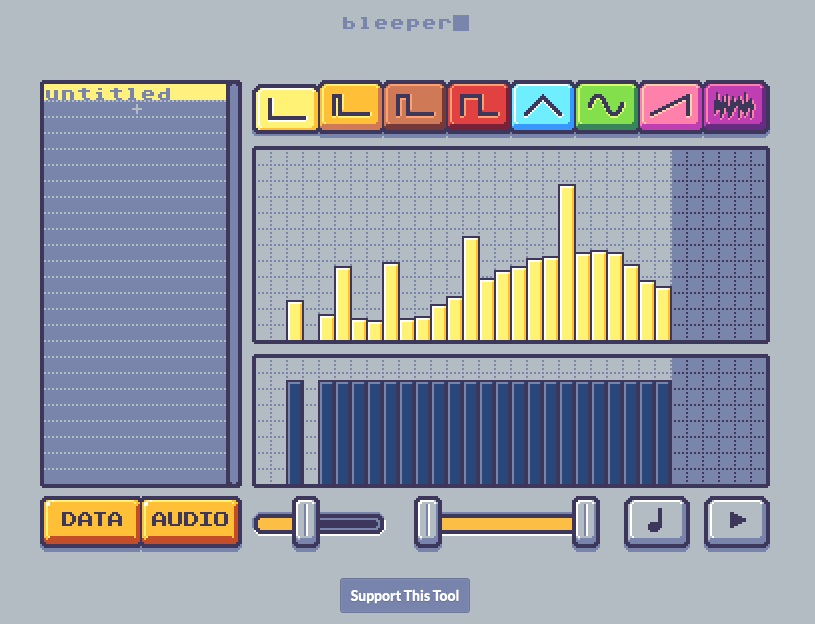
Bleeper https://pixwlk.itch.io/bleeper
After beepster, there’s bleeper!
Bleeper is for sound FX, instead of songs. This is a very adorable and very simple interface where you paint notes. Some options for waveforms are there… you don’t need to know what you’re doing. Clicking things gives results! When you’re done you can export your sound FX.
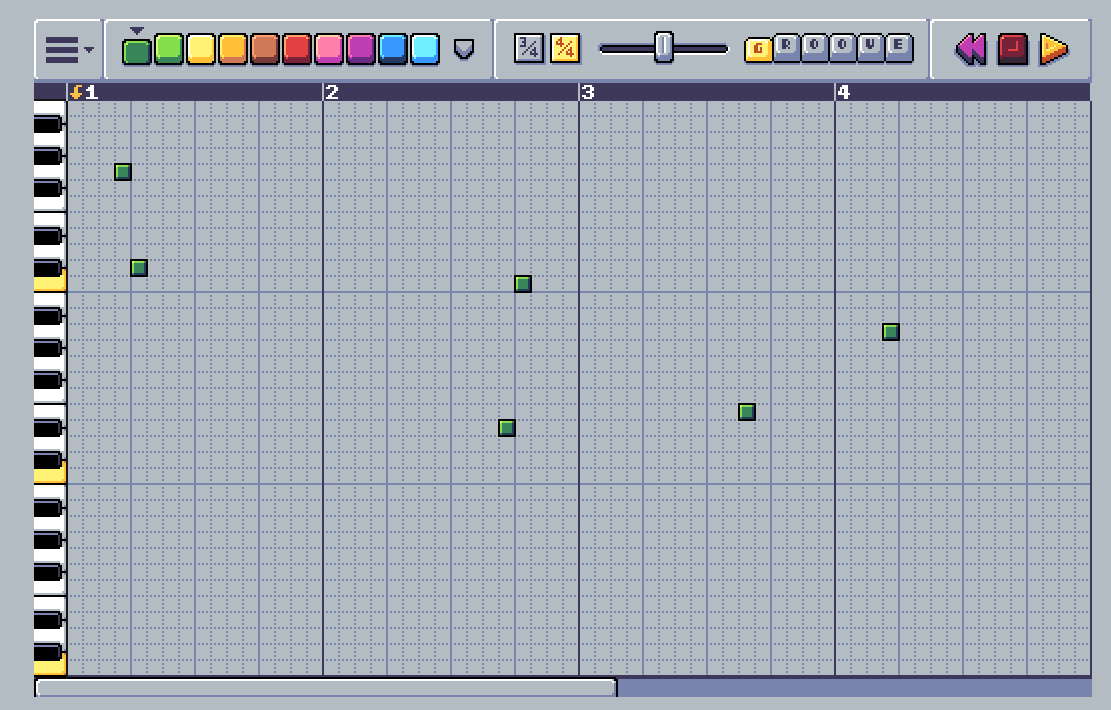
Petaporon is a simple tool that lets you compose a song with cute sounds. You can save your creation as mp3. It also gives you a quick cool sounding result. The UI on this is adorable too. There are a number of features that make it easy to use, like the keyboard keys, and ability to save the song data so you can re-load your work.
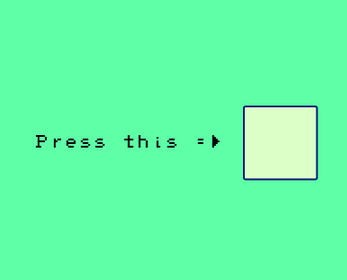
InstantChip. This is the simplest of them all. You press a button and it will generate nice sounding bloops forever.
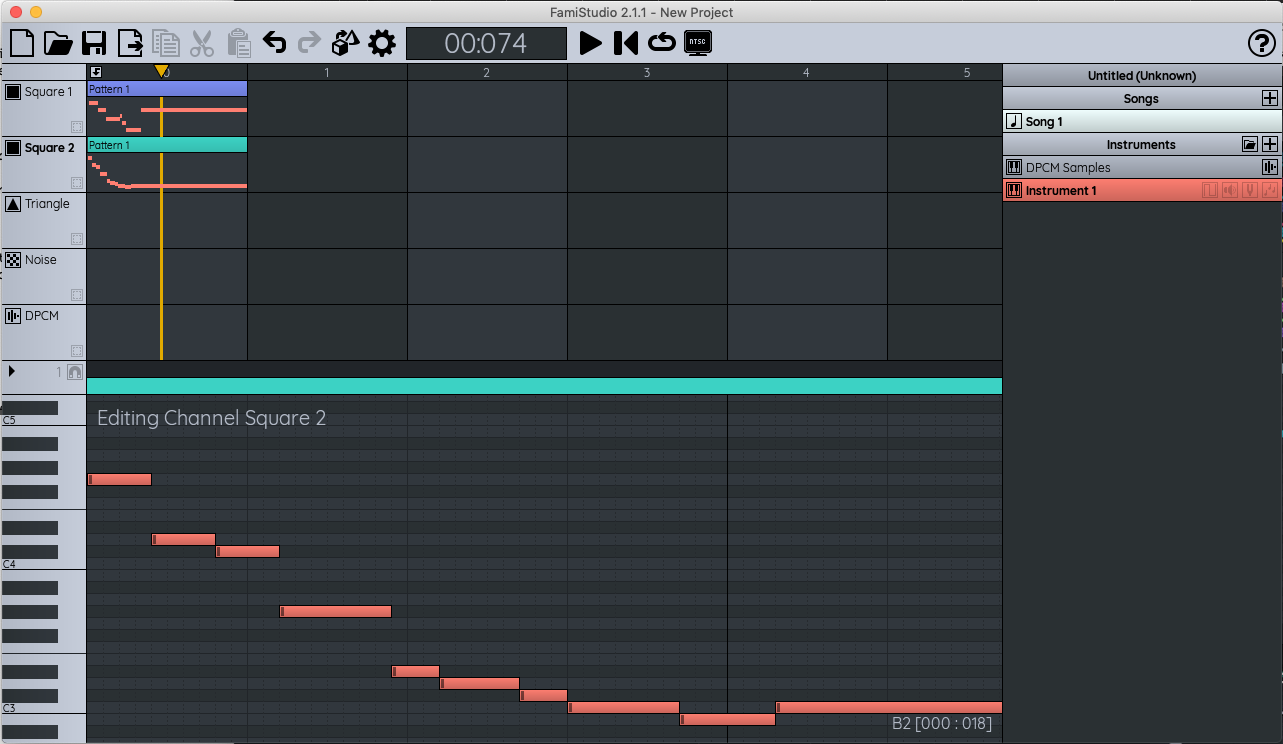
This one is a bit more complicated, but still very approachable. It’s a simple music editor for the NES, or for making NES-like music. You compose simple tunes with cute little bleeps and bloops. It outputs to a variety of formats, including .wav. It’s useful even if you’re not making something for the NES. It’s also simple enough so you don’t need to know what you’re doing to be able to make something cool.
And two final recommendations that are a lot more complex, but with more features…
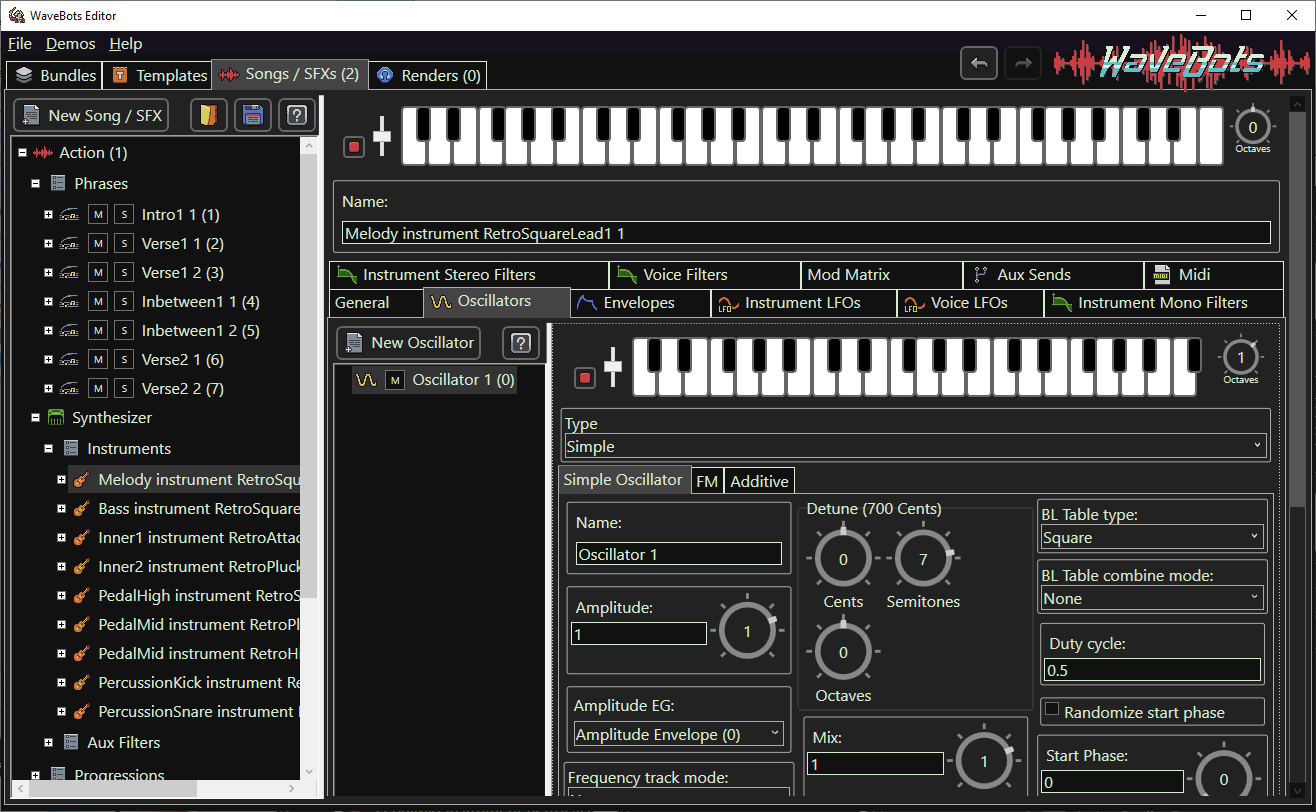
WaveBots Editor is a procedural music and sound effects generator. It’s a lot more complex, and you need to know what you’re doing, but it’s fun to get into.
And also worth playing with is Pata Tracker, a simplified music tracker to compose chiptunes.
Closing thought…
Most art software is heavily geared around the needs of the market. The things that are popular, and the things (aesthetics, approaches, formats) that we accepted as commercially necessary. Larger corporations have the resources to control that space, and be the driving force that determines software standards.
Smaller devs (especially solo devs) don’t, so essentially this space is occupied by philosophies and models that aren’t accessible to smaller devs… Can software keep experimenting even with that ever impending conservatism setting in?
This is why these tools are so valuable. Aside from just being a breath of fresh air, they keep the ecosystem alive with their new ideas and unusual ways of doing things.
It’s as vibrant of a space as the hobbyist indie game space is. I would almost go so far as to say that there basically is no difference between a small cute tool and a game. They’re both fun!
Designing them is just as involving.
If you liked this, check out this Open source, experimental, and tiny tools roundup, or my Cool Tools list on itch!
…Or go read The Zen of PICO-8.
2 Responses
[…] More from the wonderful world of tools by small devs, shareware, and freeware (art tools, music tool… […]
[…] and experimental things to be creative in + an analysis on building for approachability) More from the wonderful world of tools by small devs, shareware, and freeware (art tools, music tool… on UI design & using UI as a means to tell a story, convey emotion, create […]